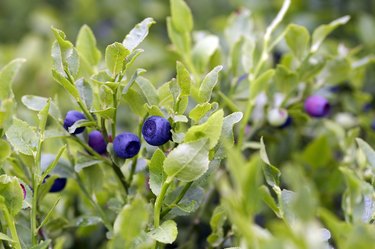
Blueberries (Vaccinium spp.) are generous garden plants that can offer scores of white blooms and nutritionally rich, sweet berries for years to come if planted in the right environment. Though blueberry leaves naturally turn yellow and red in the fall, a blueberry shrub with yellow leaves in spring or summer is likely suffering from improper soil conditions or disease. Always plant blueberries where hardy, as they will not grow well outside of their recommended climate zones. High bush blueberry (Vaccinium corymbosum) is hardy in U.S. Department of Agriculture plant hardiness zones 3 to 7, while rabbiteye bluberry (Vaccinium ashei) is best in USDA zones 7 to 9.
High Soil pH
Video of the Day
High soil pH causes yellow leaves, and is the most common reason for poor blueberry growth in the home garden. Blueberries do best in an acidic soil with a pH between 4.5 and 5.5. For established plants, you can help make up for poor soil by spraying the foliage any time during the growing season with chelated iron. Mix 1 tablespoon of iron per 1 gallon of water and use a handheld or hose-end sprayer to spray the entire shrub, including the undersides of leaves, until the solution runs off. You may need to apply again during the growing season. Avoid breathing in spray, wash hands well after applying and store unused iron in a secure location away from children and pets.
Video of the Day
Blueberry Leaf Rust
Rainy weather can provide a hospitable environment for leaf rust, a fungal disease that causes yellow spots that eventually turn rusty red. Undersides of leaves show yellow or orange pustules of spores. Rust may defoliate the shrub in severe cases. Often only a minor disease, rust must be prevented rather than treated. Limit overhead irrigation, as wet leaves encourage disease. To help prevent rust from overwintering, rake up and burn dropped leaves in the fall. You can also spray the shrub with a preventative liquid copper fungicide when leaf buds begin to open in the spring. Mix 4 to 6 teaspoons of copper per 1 gallon of water and spray evenly over the entire plant every 10 to 14 days until berries are ready for harvest. Store unused copper in a secure location away from open flame, children and pets.
Phytophthora Root Rot
Yellow leaves that turn reddish brown may be a sign that the shrub is infected by Phytophthora root rot, a soil-borne fungal disease that can develop rapidly in water-logged soils, ultimately killing the shrub. Root rot cannot be cured and is best prevented by planting disease-free blueberries in well-draining sites that are not prone to flooding and have no history of Phytopthora.
In the early stages, the disease may be slowed by moving the shrub to a site with better drainage and applying a phosphorus acid fungicide in the spring, when pink buds emerge, every 14 to 21 days until harvest. Mix 2.5 to 5 ounces of fungicide per 1 gallon of water and spray evenly over the entire plant. Store unused solution in a secure location away from children and pets.
Blueberries do best in a sunny site with acidic, well-draining soil that is allowed to dry out in between waterings. Planting on raised beds 12 inches high also helps prevent rot.
Botryosphaeria Stem Canker
Botryosphaeria stem canker is an incurable fungal disease that is favored by rainy weather. Leaves initially turn yellow or red before dying. Stems and canes are then infected, with dead leaves remaining on the plant. Cutting an infected stem will reveal streaks of brown discoloration. Infected shrubs should be removed and destroyed, as wind may spread spores to healthy plants. If you use pruning equipment on an infected plant, sterilize afterwards by soaking equipment for 5 minutes in a solution that is equal parts water and rubbing alcohol. Rinse with water afterwards and air dry.
- Oregon State University Extension: Growing Blueberries in Your Home Garden
- Cornell University: The Organic Way Preventative Disease Management for Blueberries
- Michigan State University Extension: Beware of Blueberry Leaf Rust
- University of Oregon Extension: Nutrient Management for Blueberries in Oregon
- Floridata: Vaccinium Corymbosum
- Floridata: Vaccinium Ashei
- Pacific Northwest Plant Disease Management Handbook: Blueberry (Vaccinium Corymbosum)-Root Rot
- University of Florida Extension: Disinfecting Pruning Tools
- University of Kentucky Extension: Blueberry Root Rot